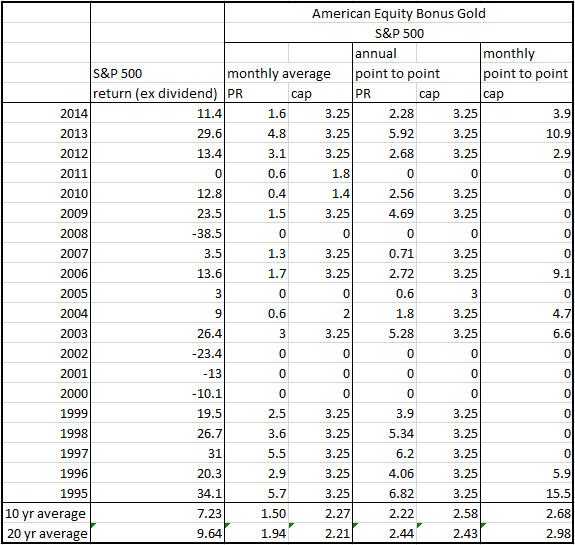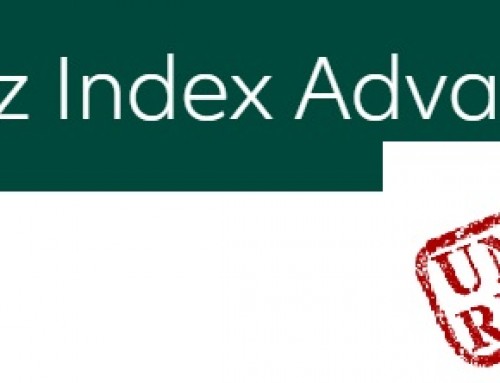The annuity business has grown in popularity as investors, especially those nearing retirement, look for options to protect themselves from stock market volatility and give them a decent income stream in retirement. With over $200 billion in annual sales, the annuity industry is big business with lots of salesmen trying to persuade you to make a purchase.
Today I will dig deep into the American Equity Bonus Gold Annuity which has been requested by several readers in recent weeks. It is one of the best-selling indexed annuities of all-time. Sales of indexed annuities, a fixed annuity that provides a minimum guaranteed rate of interest combined with an interest rate tied to movement of an index, increased to $39.3 billion in 2013, a 17% gain year over year. This is the biggest percentage increase of any form of annuity.
You will often hear that annuities are sold, not bought. This is exactly why I will go in depth into some of the most popular annuities because there is shockingly little information available about them. Most of the information comes from the companies that sell the annuities and they gloss over the fees, risks and downsides. More importantly, annuities have grown into extremely complex instruments which even the most season professional may have trouble deciphering. Indexed annuities, once considered the black sheep of retirement products, have a history of being so complex that they were a focal point of litigation and regulatory action in the 2000s. Insurers paid millions in fines. While the negative attention led to a change for the better among the carriers, indexed annuities are still complex and difficult to truly understand for many investors.
It is of the utmost importance to make an informed decision. I have dealt with too many clients that have come to me asking for help getting out of an annuity and I can’t help after the fact. Stiff surrender penalties can’t be avoided for many years. This annuity has one of the longest and most onerous surrender periods that I've ever seen so before you sign on the dotted line, you better be 100% sure you are making the right decision.
Perspective That You Can Trust
I am writing this blog from the perspective as a curious analyst. I am totally impartial as I am a fee-only registered investment advisor. I hope to bring a unique perspective to this topic drawing on my years of experience analyzing companies as a research analyst. I’ve met with hundreds of company CEOs and CFOs, including Steve Jobs and Richard Branson, and I will use my analytical skills to break down these complex instruments into something easier to understand.
While many investment professionals hate annuities, I do not believe that they are all bad and some of them can make sense as a small part of your investment portfolio. Annuities should never, I repeat never, be the large majority of your portfolio because of their lack of liquidity which is one of their biggest drawbacks.
Issuer Review: American Equity Investment Life
It is important to look at the issuer of the annuity first because annuities are NOT a guaranteed investment. This is important to note so I will say it one more time. Annuities are NOT guaranteed. They are only backed by the ability of the issuing insurance company’s ability to pay. State Guaranty Associations offer some protections but the levels vary state to state.
American Equity Investment Life was formed in 1981 and became a public company in 2003. As per the company website, it has over 23,000 active agents and 350,000 policy holders. It is #3 all-time in indexed annuity sales.
American Equity Investment Life Insurance Company is rated A- (Stable outlook) by AM Best, BBB+ (Positive outlook) by S&P and BBB+ (Stable outlook) by Fitch. Most recently, Fitch reaffirmed its rating in November of 2014. Fitch stated “The affirmation of AEL's ratings reflects high credit quality within AEL's bond portfolio, continued good operating results, adequate risk-adjusted capitalization and the company's strong competitive position in the fixed indexed annuity market. The rating also reflects AEL's high, albeit declining financial leverage, above-average exposure to interest rate risk and lack of diversification in earnings and distribution.”
The American Equity Bonus Gold annuity has been one of the best-selling fixed indexed annuities for several years. So let's take a deeper dive into the details…
Annuity Review: American Equity Bonus Gold
Maximum age for initial purchase: 80
Minimum initial premium: $5,000
Free look period: 15 days (may vary by state)
Lifetime Income Benefit Rider (LIBR): 0.60% (IAV rate of 6.5%); no rider fee with IAV rate of 4.5%
LIBR and Enhanced Death Benefit Rider: 0.70%
LIBR and Wellbeing Rider: 0.75%
Website: http://www.american-equity.com/
Agent commission: up to 9%
Beware of Surrender Fees
Surrender charges and period for this annuity are extremely high, in fact they are the worst I've seen to date. Surrender fees go for 16 years and are over 10% for the first 12 years! This is essentially illiquid for those years unless you just want to give your money away to American Equity. On the bright side, you can withdraw 10% penalty free per year after your first contract anniversary. They also have two riders that are available if you wind up in nursing care or have a terminal illness (with less than a year to live).

I believe surrender fees are one of the worst features of annuities. These are huge lockup fees and if you need the money, they sock it to you. This is why annuities should NEVER be a significant part of your investment portfolio because they are essentially illiquid for many years. Unless you are positive you will not need access to these funds, then annuities are NOT for you.
The American Equity pitch as per their brochure
American Equity highlights these points:
- safety of principal
- guaranteed income
- liquidity
- income taxes
- avoidance of probate
How will you likely be pitched this annuity?
This indexed annuity (also called an equity-indexed annuity, fixed-index annuity or hybrid annuity) will likely be packaged around these main components:
- Principal protection with upside potential from their attractive index choices
- 10% bonus with immediate vesting
- Guaranteed income for life with LIBR (lifetime income benefit rider)
Like most index annuities, agents likely appeal to your sense of fear for the stock market and potential downside risks. On the positive side, this annuity will protect you from downside and can provide income for life. While this is certainly true, one of the biggest issues is that there is a lot of miscommunication and misunderstanding between agents and potential buyers. This is a huge issue and can lead to very unhappy buyers because their expectations aren't met later and due to the long surrender period they are locked in for a very long time.
Because the roll up rate on the LIBR can be 6.5% and payout rates can rise to up to 6.5%, some buyers seem to believe that this is their actual return. A consumer watchdog reporter just came to me with this type of example where a 70 year old buyer believed he would earn a 6% return with no downside risk and was shocked after one year when his return was essentially flat. His mistake was not knowing the difference between account value and income account value. There is a huge difference.
If your agent explains this annuity correctly, you should understand the nuances and you should never get the impression that you'll earn more than 5% returns in today's zero rate environment. Based on current caps and participation rates, the more realistic expectation for returns is in the 2-4% range and I would guess that it would be at the lower end of that range given historically low yields in the bond market. While the 10% bonus vests immediately, American Equity protects itself by setting double-digit surrender fees for the first 12 years of this annuity.
Let's dig into this annuity so you have a better understanding of the nuts and bolts…
Interest Crediting Options
It is important to understand that you are not investing in the underlying securities of any index. With index annuities, you are not making investment choices like a variable annuity. Your interest crediting options are mathematical formulas that the insurance company is using to attract you into buying xyz annuity. The insurance company invests your money in whatever they choose (likely diversified, conservative investments). They just have to earn a return higher than their mathematical formula (or interest crediting option) so they can pay you, their sales force, marketing, operations, etc. This is why index annuities will only generate low single-digit returns.
For the Bonus Gold annuity, you may select from bond, equity and fixed interest crediting methods. You can choose from the S&P 500 Index, the S&P 500 Dividend Aristocrats Daily Risk Control 5% Index, the Dow Jones Industrial Average (DJIA) and 10-Year US Treasury Bond. To make it a bit more complex, you have different crediting methods: monthly point to point crediting, annual point-to-point crediting, annual monthly average crediting, price triggered, bond yield with cap, volatility control and fixed interest. So let's dig a bit deeper into your choices.
As of January 1st, 2015, the Fixed interest allocation is currently paying 1.35%. This is slightly better than a 5-year Treasury Note at 1.28%. You can likely beat the fixed account on your own.
So onto the Indexed interest options. Many salespeople may sell you on high returns but none of these options will deliver much more than 3% returns. If someone is promising higher returns (above 5%) then you need to find a more honest agent. Whatever option and crediting method you choose, you will likely make around 1-3% over the long term. I will illustrate this for you.
Please note that backtesting is not utilized by American Equity. All illustrations that follow are performed by the author given rates at the time of publication (these are subject to change over time).
Let's first look at the monthly point to point crediting method which looks at the index return with a cap (as of 1/1/15, the S&P 500 cap is 1.6%). This cap can be changed after the 1st year of your contract. There is no cap on negative months. For example, if the S&P went up 6% in January, you'd be credited with 1.6%. However if the S&P went down 7%, you'd be credited with -7% for that month. At the end of the year, the totals are added up and that is your return for the year. If it is negative, you don't lose anything. Here is a hypothetical example for 2012 using current caps:
| Date | S&P 500 | Monthly % chg | Bonus Gold |
| Jan-12 | 1312.41 | 4.36 | 1.60 |
| Feb-12 | 1365.68 | 4.06 | 1.60 |
| Mar-12 | 1408.47 | 3.13 | 1.60 |
| Apr-12 | 1397.91 | -0.75 | -0.75 |
| May-12 | 1310.33 | -6.27 | -6.27 |
| Jun-12 | 1362.16 | 3.96 | 1.60 |
| Jul-12 | 1379.32 | 1.26 | 1.26 |
| Aug-12 | 1406.58 | 1.98 | 1.60 |
| Sep-12 | 1440.67 | 2.42 | 1.60 |
| Oct-12 | 1412.16 | -1.98 | -1.98 |
| Nov-12 | 1416.18 | 0.28 | 0.28 |
| Dec-12 | 1426.19 | 0.71 | 0.71 |
| 13.40 | 2.86 |
In 2012, if you actually invested in the S&P 500 by purchasing an exchange traded fund like SPY, you would have been up 16% thanks to price appreciation and dividends. The S&P 500 without dividends was up 13.4%. In the Bonus Gold Annuity, if you selected monthly point to point crediting, you would be credited with a gain of just 2.86%. If you selected the annual point-to-point crediting option, you would receive 3.25%. It is important that note that American Equity can change your caps after your contract anniversary.
Let's take a look at how the Bonus Gold annuity would fare (at current cap rates) over the last 10 and 20 years for the S&P 500 options. Note that these are hypothetical returns based on current rates as of 1/1/15:

In this hypothetical example, the monthly point to point method performed the best out of the index crediting options for the S&P 500 with close to a 3% return for 20 years. However, as you can see, all of these options produced between 1.5-3% and that should be your expectation for real returns in today's low rate environment.
Some agents will pitch the bond yield with cap as most index annuities aren't providing a bond option. This appeals to people that fear the stock market and believe that the bond market is more stable. On each contract anniversary, the bond price is compared to the bond price on the previous anniversary. The index credit is based on the decrease in the bond price. The BYC interest credit calculation is determined by first applying the cap (2.75% as of 1/1/15) followed by the asset fee. This option will do alright in a rising rate environment but in a year like 2014 where yields declines and prices rose, you would not fare well.
If you have additional questions about these options, please submit a question using our secure form. We will answer your questions as soon as possible (often under 24 hours) via email. No strings attached, just a little free help to point you in the right direction.
Who should buy this product?
In summary, the Bonus Gold Annuity is something to consider for someone that doesn't want to worry about market volatility, wants a guaranteed income stream and is happy with low single-digit returns of roughly 1-3% which most indexed annuities will return. The annuity can make sense for an extremely conservative investor who is looking for guaranteed income with no market risk.
This product will work best for those that are in good health and have a family history of longevity. If you can live to your late 90s, then the guaranteed income stream will pay off nicely. However for most of us that live an average lifespan or even into your 80s, then a conservative portfolio of stocks and bonds will likely be a better choice in terms of return and with much higher liquidity. Be sure to evaluate how it fits into your entire investment strategy and how it will help you reach your financial goals.
In the end, all of the interest crediting options will pay roughly 1-3% over a full market cycle.
Don't buy into any sales pitch that is promising rates of return of 6-10% or more. It just isn't possible to generate 10% returns with no downside risk. If anyone promises you even 6%+ returns for this annuity, don't just walk away, run for the door and find a new advisor. For American Equity to pay 6% on this annuity, they would have to earn 9%+ on their own investment portfolio so they could pay you as well as their salespeople, marketing and overhead, not to mention to earn a profit themselves. Commissions are very lucrative for agents selling the Bonus Gold (up to 9%) so be sure that you make the right decision for you, not for their benefit.
Thanks for sticking with me on this incredibly long blog post. I learned a lot in my research process and I hope you are able to make a more informed investment decision because of it. Please don’t let your agent pressure you into a sale before you have made an informed decision. Since annuities lock you into a long-term contract with stiff surrender fees, please be sure to take your time to make the best possible decision for you and your family.
Have questions about this Annuity?
If you're considering this annuity and have additional questions, feel free to reach out. You can contact us via our secure contact form. We will answer your questions as soon as possible (often within 24 hours) via email. No strings attached, just a little free help to point you in the right direction.
Please share your experiences and thoughts in the comments section below.
“Annuities stock photo” by lendingmemo_com is licensed under CC BY 2.0
By Chris Wang






